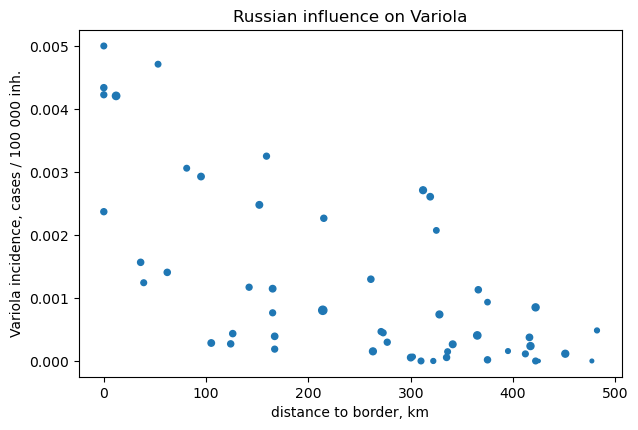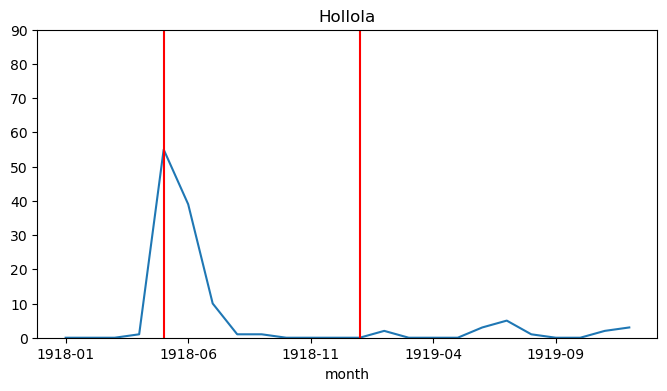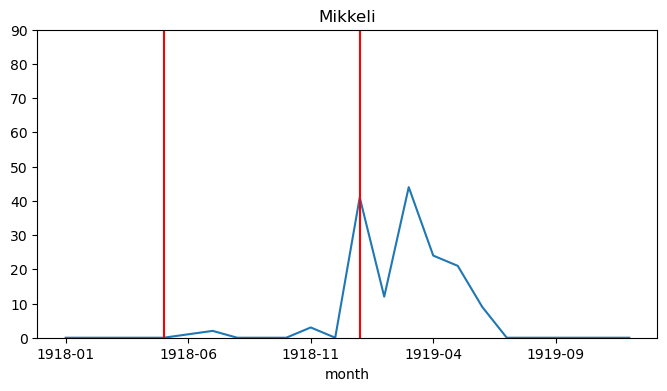Spatio-temporal dynamics of the last Finnish Variola epidemic, 1918–19
Antti Härkönen
2023-11
Introduction
Variola
- Orthopox virus
- Smallpox, la petite vérole, isorokko, smittkoppor
- One of the deadliest diseases in history
- 30 % mortality
- 300 million dead in 20th century
- Killed 20–30 % of Finnish children in the worst periods
- Wiped out by vaccination campaign in 1980
Vaccination
- Jennerian vaccination in the late 1700s
- Mandatory vaccination for children in Finland in 1883
- Smallpox no longer endemic in Finland after 1890s
However…
- Widespred vaccine hesitancy
- Kuhnean antivaccine movement popular in the 1910s
- Smallpox still endemic in Russia proper
Finnish Civil War and Disease
WWI
- Before the revolutions of 1917 WWI affected Finland very little
- Several diseases spread near frontlines
- German army suffered 1 dead from disease for every 10 KIA
- Influenza pandemic of 1918–19 killed 500 million people world wide
Finnish Civil War
- Peacetime medical infrastructure breaks down
- Reds had much worse medical corps than Whites
- Did not trust doctors
- Large movements of people
- Armies
- Refugees
- Economic migrants due to famine conditions
- Prisoner transfers
- People crammed in barracks and in prison camps
Smallpox in Civil War
- Local smallpox cases in Karelian Isthmus in 1916
- Several outbreaks during and after the civil war
- Smallpox spread among Red troops and then in prison
camps
- 3000 cases and 900 deaths
Civilian cases
- Recruits and prisoners returning spread cases
- In many areas civilians did not recognise the disease as smallpox
- Origin sometimes unknown
- Doctors suspected Variola had spread from Russia
- One large wave at the end of the Civil War
- Second, more dispersed wave in early 1919

Prevention of smallpox
- Quarantining was the most important way of prevention
- Increased vaccination, targeted vaccination efforts
- Similar to later WHO eradication campaign!
- White troops and red prisoners vaccinated
- Desinfections of barracks
Eastern Border
- Refugees from Russia often had smallpox infections
- Mandatory checks at the border, quarantine hospital
Data
Healthcare districts
- Finland was divided into 53 medical districts piirilääkäripiiri
- The area of districts evolved over time
- Each had a district medical officer
(piirilääkäri) charged with reporting on local conditions
- Medical statistics do not correspond to other statistical units
- Cities had their own medical boards
Medical data
- Annual reports of the Central Medical Board (Lääkintöhallitus) report diseases by medical districts and cities
- These do not include the many cases in garrisons and prison camps
- No good data on vaccine coverage
Spatial data
- Finnish municipalities in 1918 digitized, then combined into medical districts
- Cities are included in the district that surrounds them, in reality they were independent units
Geospatial analysis
Distance to Russia and Variola
- x_i distance to Russian border (100 km) measured for each medical district i
- y_i incidence of Variola

Bayesian spatial Poisson regression
- Incidence is modelled with a type of Generalised Linear Model (GLM), where the response variable is Poisson-distributed
- Bayesian regression:
- Distribution of model parameters are estimated based on data
- Data is a given, model parameters vary
- Prior distributions incorporate prior knowledge
Model (1/2)
\[ y_i \sim Poisson(\lambda_i) \] \[ \log{\lambda_i} = \beta_0 + \beta_1 x_i + \theta_i + \phi_i \] \[ \beta_0 \sim Normal(\mu=4, \sigma=0.05) \] \[ \beta_1 \sim Normal(\mu=0, \sigma=0.05) \]
Model (2/2)
\[ \theta_i \sim Normal(\mu=0, \tau=\tau_{independent}) \] \[ \phi | \phi_{j~i} \sim Normal(\mu=\alpha \sum^{n_i}_{j=1} \phi_j, \tau=\tau_{spatial}) \] \[ \tau_{independent} \sim Gamma(\alpha=1, \beta=1) \] \[ \tau_{spatial} \sim Gamma(\alpha=1, \beta=1) \]
Results
- 95 % credible interval (CI) for β_1
indicates significant effect of distance to Russia (x_i)
- 1918 CI: from -0.0064 to -0.00078
- 1919 CI: from -0.014 to -0.0028
- very small numbers are explained by the fact x_i is measured in hundreds of km
The two waves
1918 vs 1919
- Two distinct peaks in reported civilian smallpox cases
- End of the Civil War, May 1918
- Winter and Spring 1919

Local patterns
- Two peaks
- Peak in 1918, no peak in 1919
- No peak in 1918, peak in 1919
- Very few or no cases
1. Two peaks
- Karelian Isthmus and Ladoga coast
- Areas most dependent on Petrograd before 1917
- Tampere region
- The city itself had high vaccination rate
- Kuopio: first wave from prisoners, second wave from North Karelia

2. Peak in 1918, no peak in 1919
- Historic Tavastia and Birkaland, except Tampere

3. No peak in 1918, peak in 1919
- Areas outside of the most intensive fighting in the Civil War
- Mostly areas influenced by Viipuri and Petrograd (before 1917)
- Pori district in the west

4. Very few or no cases
- Northernmost Finland was safe, likely due to the very low population density
- Western islands protected by Baltic sea
- Smallpox needed higher population density to survive than the Spanish flu

Summary
Russian influence
- Distance to Russia explains east-west differences within Finland
- Finnish civil war explains outbreaks in the south
- Quarantine hospital at border prevented many outbreaks
Smallpox
- The problems faced by medical professionals were almost exactly the same as the ones during COVID-19
- Data quality and lack of digitisation are huge problems
- Variola virus is the only pathogen ever to be extinguished by humans